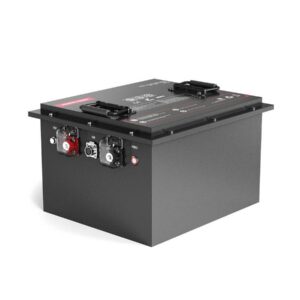
What does the RC number mean on a battery?
The RC (Reserve Capacity) number indicates how long a 12V battery can deliver 25 amps at 80°F before dropping below 10.5V. Measured in minutes, it quantifies backup power for critical systems if the alternator fails. Higher RC values (e.g., 180 minutes) benefit vehicles with high accessory loads like RVs or marine applications. Flooded lead-acid typically offers 90-120 RC, while AGM/Lithium reach 150-200+.
Best Replacement 12V Battery Brands for Toyota Prius
How does RC differ from CCA?
RC measures sustained energy delivery, while CCA (Cold Cranking Amps) tests short bursts for engine starts. RC focuses on 25A over hours; CCA measures 0°F amps for 30 seconds. Trucks need high CCA; RVs prioritize RC.

Think of CCA as a sprinter and RC as a marathon runner. A 750 CCA battery might start your diesel truck instantly but only power lights for 90 minutes. Conversely, a 180 RC marine battery could run trolling motors all day but struggle with cold starts. Pro Tip: For dual-purpose use (e.g., plow trucks), seek batteries with both 800+ CCA and 120+ RC. Testing standards differ too—RC follows SAE J537, while CCA uses SAE J1374. Ever wonder why some batteries excel at one but not the other? It’s all in the plate design: thick plates for RC durability vs. porous plates for CCA surface area.
What factors influence a battery’s RC rating?
Plate thickness, electrolyte volume, and chemistry dictate RC. Thicker plates withstand deeper discharges, while AGM’s fiberglass mats reduce resistance. Lithium’s 95% depth of discharge (vs. 50% in lead-acid) triples effective RC.
Consider two 100Ah batteries: a flooded lead-acid with 120 RC and a LiFePO4 with 200 RC. The lithium unit achieves this through lower internal resistance (<0.03Ω vs. 0.06Ω) and stable voltage curves. Electrolyte plays a role too—AGM batteries trap liquid, allowing faster ion movement. But here’s the kicker: temperature swings alter RC dramatically. At 32°F, a lead-acid battery’s RC drops 30%, whereas lithium maintains 95% capacity. What’s the real-world impact? An RV fridge drawing 8A would run 15 hours on a 120 RC battery (120 mins * 25A = 50Ah; 50Ah/8A ≈ 6.25h). Wait, that math doesn’t add up! Actually, RC uses 25A, so runtime = RC * (25/actual load).
| Factor | Lead-Acid Impact | Lithium Impact |
|---|---|---|
| Plate Thickness | +15% RC per 0.2mm | N/A (No Plates) |
| Temperature | -1% RC/°F below 80°F | -0.2% RC/°F |
Why is RC critical for marine applications?
Boats need extended runtime for fish finders, bilge pumps, and trolling motors without engine recharge. A 150 RC marine battery provides 62.5Ah (150 * 25A / 60), powering a 10A trolling motor for 6+ hours.
Imagine being stranded with a dead battery 5 miles offshore. Marine systems often draw 15-30A continuously—without sufficient RC, you’re paddling. AGM batteries dominate here due to vibration resistance and 0.1% monthly self-discharge (vs. 5% in flooded). Pro Tip: Always oversize RC by 20% for marine use; corrosion and parasitic loads erode capacity. Did you know lithium batteries bypass the 50% discharge rule? Their 100% usable capacity effectively doubles RC compared to lead-acid. For example, a 100Ah LiFePO4 (200 RC equivalent) outlasts a 200Ah lead-acid (100 RC) in deep-cycle scenarios.
How to calculate device runtime using RC?
Divide RC by (device amps / 25A). A 180 RC battery running 10A devices lasts 180 / (10/25) = 450 minutes (7.5h).
Let’s break this down: RC is measured at 25A, so scaling linearly gives runtime. A 50A inverter load would cut runtime to 180*(25/50)=90 minutes. But wait—real-world efficiency losses matter. Lead-acid efficiency drops to 85% under high loads, while lithium holds 95%. So that 7.5h becomes 6.4h for lead-acid. Always factor in Peukert’s Law: Runtime = (RC * (25/I)) / (1 + 0.03*(I-25)), where I is actual current. For 30A: 180*(25/30)/(1+0.15) ≈ 107 minutes. Why does this matter? Oversized loads destroy RC accuracy—always check load specs against battery curves.
| Load (A) | Adjusted Runtime | Efficiency |
|---|---|---|
| 10 | 7.5h | 92% |
| 30 | 1.8h | 78% |
Can you improve a battery’s RC?
Yes, via temperature control, regular maintenance, and partial discharges. Keeping lead-acid above 50°F preserves RC; lithium handles -4°F to 140°F.
For lead-acid, equalization charges every 10 cycles remove sulfate buildup, recovering 5-10% RC. AGM benefits from voltage-regulated charging (14.4-14.6V). Lithium’s RC stays stable but avoid 100% DoD—keeping between 20-80% extends cycle life. Ever seen RC drop 40% in a year? That’s plate sulfation. A desulfator pulse (40-60Hz) can reverse it. Pro Tip: Add battery heaters ($50-$150) for winter RC retention. Upgrading to lithium? A 100Ah LiFePO4 replaces 220Ah lead-acid for equal RC, saving 150lbs. But remember—RC isn’t everything. High-cycle batteries sacrifice some RC for longevity; choose based on use case.
What Is the Best Battery for a Diesel Pickup Truck?
Battery Expert Insight
RC ratings define real-world endurance—critical for applications where alternators can’t recharge. We optimize plate alloys and electrolyte chemistry to push lead-acid RC to 150+ minutes, while lithium’s flat discharge curve delivers true capacity. Always cross-reference RC with Peukert numbers; a 180 RC battery under 50A loads performs worse than spec. Smart BMS in lithium units dynamically adjusts for load/temperature.
FAQs
Does higher RC reduce battery life?
In lead-acid, yes—deep discharges for RC tax plates. Lithium handles 100% DoD, so RC gains don’t compromise lifespan.
Is RC more important than Ah?
Ah measures total energy; RC indicates delivery under load. For UPS systems, RC matters most; solar storage prioritizes Ah.
How to check my battery’s RC?
Use a load tester: Apply 25A until voltage hits 10.5V. DIY methods risk damage—consult professionals.
